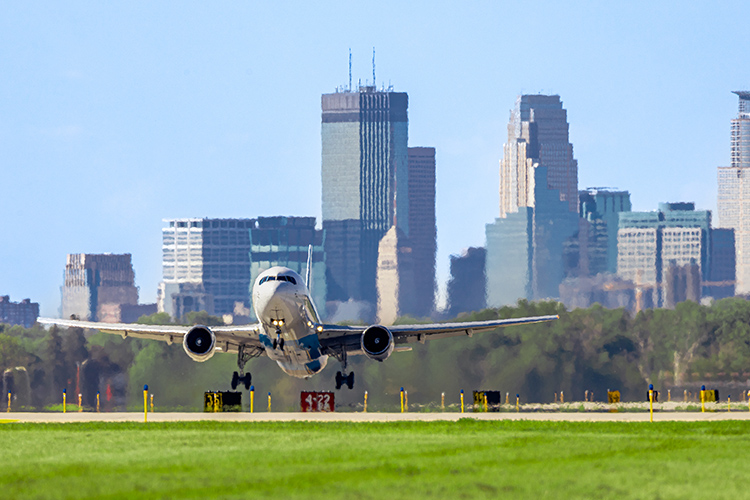MSP Airport Passenger Traffic Increased 24% in 2022
Key Trends: More International Travel and Changing Aircraft Fleet

MINNEAPOLIS-ST. PAUL – Minneapolis-St. Paul International Airport (MSP) surpassed 31.2 million total passengers in 2022, marking a 24% increase in passenger activity compared to 2021. MSP’s year-end passenger and operations report released today shows the airport is on a steady and promising recovery path after three years of impacts from the COVID-19 pandemic.
“Our recovery over the last year included several bright spots, highlighted by a continued expansion of domestic routes and a significant rebound in international service,” said Brian Ryks, CEO of the Metropolitan Airports Commission, which operates MSP. “As we look to further close the gap to pre-pandemic passenger levels, we’re encouraged airlines have already announced new destinations and flight frequencies for 2023 and that they continue to utilize larger aircraft with more seat capacity to meet increased demand out of MSP.”
MSP’s 31.2 million passengers in 2022 marks a 79% recovery to the 39.6 million total passengers in 2019. Passenger activity dropped to 14.9 million in 2020 and has increased by 16.3 million passengers over the last two years. MSP supported 310,235 aircraft operations (takeoffs and landings, all types of aircraft) in 2022, up 2% from 2021’s 303,892 operations.
Click here for a summary of 2022 MSP statistics.
Scheduled passenger airline flights accounted for 89% of all aircraft operations at MSP, averaging 756 per day, up from a daily average of 741 in 2021. Another airline trend in the last year has been the change in fleet mix. Airlines at MSP are increasingly operating routes with larger aircraft—which offer more seats per flight—to meet demand across their networks. Available seats on all departing flights grew by 7% in 2022 compared to the previous year.
Major airline carrier operations grew more than 19% in 2022, totaling 180,798 operations. Operations by regional airlines, which typically fly 50-76 seat aircraft, totaled 95,248 — a decline of 20% versus 2021.
Total non-stop destinations grew to 145 – up from 137 in 2021 – due to a combination of new routes and returning destinations previously paused during the pandemic. International travel saw its most significant rebound from pandemic impacts in 2022, with more than two million passengers flying to or from the Twin Cities. This is a 175% increase over 2021. The restart of several international routes included Delta’s non-stop service to London and Seoul, and Condor’s route to Frankfurt. Air Canada and Sun Country also launched new non-stops from MSP to Canada - Montreal and Vancouver, respectively.
The top five airlines in passenger market share in 2022 were:
|
1. |
Delta* |
71.10% |
|
2. |
Sun Country |
10.80% |
|
3. |
American* |
4.60% |
|
4. |
Southwest |
4.40% |
|
5. |
United* |
4.20% |
Percentages rounded. *Includes regional affiliates.
The most popular passenger aircraft at MSP in 2022 was the Boeing 737-800 with more than 35,800 operations, or 11.7% of all jet activity. The Airbus A321 was a close second with more than 35,500 operations, or 11.6% of all jet operations at MSP.
The total amount of cargo goods transported through MSP held steady in 2022, totaling 236,450 metric tons.
To start 2023, airlines are operating an average of 358 departures a day, with first quarter total seats tracking 7.5% greater than 2022. Airlines have announced 20 new domestic routes from MSP for the current winter season or upcoming summer, including new non-stop service to Atlantic City, NJ; Colorado Springs, CO; Melbourne, FL; and Wilmington, NC.
About The Metropolitan Airports Commission (MAC)
The Metropolitan Airports Commission (MAC) owns and operates one of the nation’s largest airport systems, including Minneapolis-St Paul International (MSP) and six general aviation airports. The MAC’s airports connect the region to the world and showcase Minnesota’s extraordinary culture to millions of passengers from around the globe who arrive or depart through MAC airports each year. Though a public corporation of the state of Minnesota, the organization is not funded by income or property taxes. Instead, the MAC’s operations are funded by rents and fees generated by users of its airports. For more information, visit www.metroairports.org.
FREE Whitepaper
PAVIX: Proven Winner for All Airport Concrete Infrastructure
International Chem-Crete Corporation (ICC) manufactures and sells PAVIX, a unique line of crystalline waterproofing products that penetrate into the surface of cured concrete to fill and seal pores and capillary voids, creating a long lasting protective zone within the concrete substrate.
Once concrete is treated, water is prevented from penetrating through this protective zone and causing associated damage, such as freeze-thaw cracking, reinforcing steel corrosion, chloride ion penetration, and ASR related cracking.
This white paper discusses how the PAVIX CCC100 technology works and its applications.








